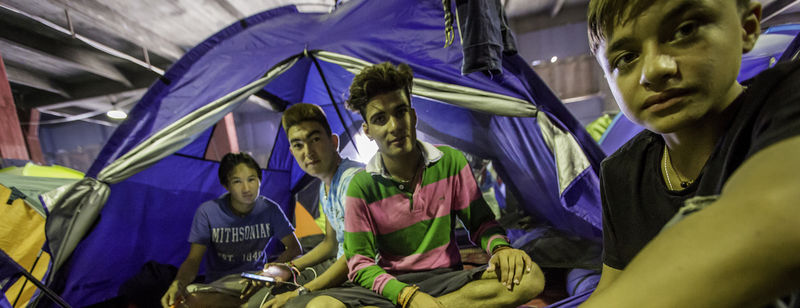The technology website CNET this summer sent about a dozen journalists to report on the refugee crisis from 10 countries around the globe. They’re producing in excess of 60 stories exploring the ways technology helps refugees navigate the long journey from their home countries to asylum abroad. The stories range from in-depth, long-form feature articles and opinion pieces, to photo galleries, videos, and podcasts.
The effort, motivated in part by an image of a dead Syrian boy that went viral last year and has come to represent the refugee crisis, is something of a departure from CNET’s usual bread-and-butter desk reporting of tech news and product reviews, a strategy that has netted them more than 30 million monthly readers. “Road Trip 2016: Life, Disrupted” is the latest and most ambitious project in a larger effort by CNET News Editor in Chief Connie Guglielmo–who joined the company from Forbes in March 2014–to incorporate more in-depth analysis about the cultural impact of technology into CNET’s coverage.
The expansion of their editorial purview comes at a time when many traditional newsrooms, including The Los Angeles Times and Newsday, have pulled back on foreign reporting. The shift puts CNET among other digital-first media organizations, such as Buzzfeed and the Huffington Post, which have made unexpected investments in the kind of in-depth, on-the-ground journalism many feared could become a thing of the past. CNET declined to disclose how much it invested in the refugee reporting project.
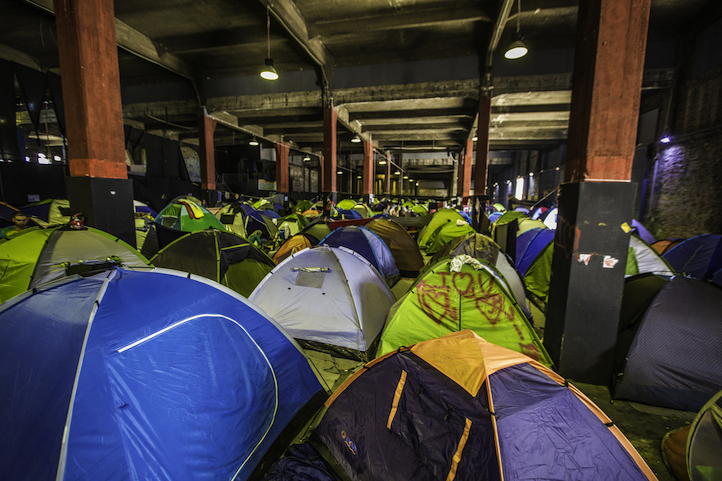
Thousands of refugees and migrants are stranded in Greece. Activists in Athens are helping a few find decent shelter, while others live in makeshift camps.
“Life, Disrupted” launched August 3 with a multimedia package of stories about the refugee situation in Greece. CNET plans to post a new package each week until mid-September covering the crisis in countries far and wide, including France, Australia, the UK, Sweden, Finland, Germany, as well its effects on cities across the US.
CNET has unearthed some surprising findings that get to the heart of technology’s dual role as both a positive and negative force in people’s lives. For example, an upcoming story about a government-run camp in France details how fingerprint scanners that monitor access to the camp are a deterrent for refugees who are required to apply for asylum in the first country they arrive at in Europe. Many refugees have a particular country they are trying to reach and don’t want a record in the system until they get there. “Some people were opting to live in squalid conditions down the road [rather] than in the more secure, better-equipped camp because they feared that particular technology,” says Guglielmo.
CNET’s reporters describe how, in camps with limited electricity, charging stations become gathering places and smartphones have gone from a luxury to a tool of survival. “One refugee we spoke with in a detention center off the coast of Australia sold his clothes to buy a phone through the black market,” says Guglielmo. The phones are also time capsules, storing memories of a previous life, as well being an important repository for identity documents, and a way to stay connected to family left behind. In a camp in Calais, France, a bus operated by a charity group delivers mobile Wi-Fi to residents in a place where most people can’t afford a data plan for their phone.
Not surprisingly, technology also played a key role in the reporting process. The team bound for Athens began to connect with refugees on social networks, messaging groups, and underground websites prior to their arrival on location, but it wasn’t until they were on the ground that they realized how significant a role these sites played in the way refugees connected with each other, and with charity agencies, to organize shelter. “One Facebook group led us to another and that led to another, which is why were were able to do one of the earliest detailed reports about squats in Athens,” says Guglielmo.
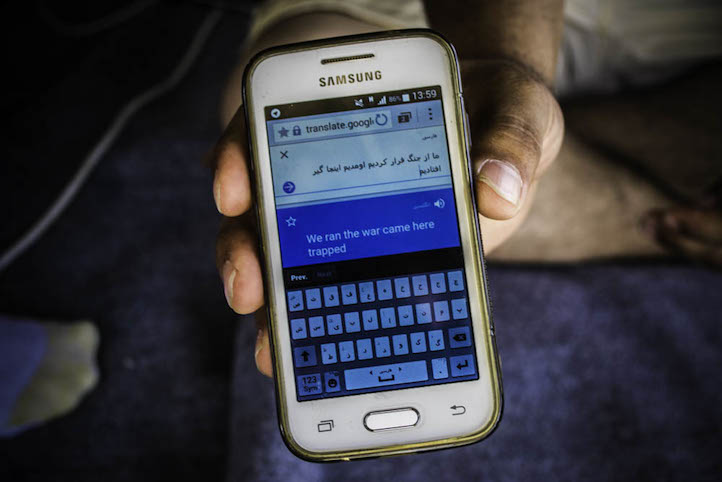
Social networking apps and Google Translate are standard fare for most refugees.
Reporters were equipped with all the usual gadgets essential for modern storytelling–high-end smartphones for taking photos and videos, laptops and Wi-Fi modems for backing up materials to Google Drive, and a Samsung 360-degree camera. One essential was Google Translate, which aided communication between reporters and refugees, who spoke a myriad of languages. Reporters Ben Fox Rubin and Richard Nieva describe it as a lifeline. “We type out full sentences in English so [our source] can read them in Arabic,” they write. “For him, though, it’s an occasional crutch. He speaks English as much as possible, only relying on the app to summon a few words when he can’t think of them.”
The stories are peppered with reflections and anecdotes about the process, and several stories have a behind-the-scenes feel. In this piece, CNET photographer James Martin–who snapped more than 5,000 photos while he was in Greece–recounts his journey to create a photograph of a pile of abandoned life jackets, known as the life jacket memorial, left by refugees who landed in Lesvos. In another piece, Ben Fox Rubin discusses the emotional impact of meeting a child whose father was killed in Syria. That was a concerted decision by Guglielmo. “We’re people, we live in this world. We interact, we have thoughts, we have opinions. Our goal is to try to temper all that when we tell a story and be as complete and as straightforward as we can, but I did want the reporters to share that to humanize the reporting experience.”
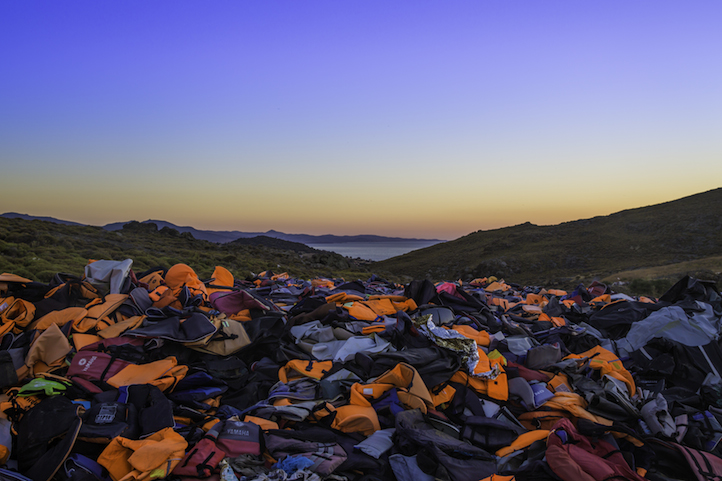
A view of the life jacket memorial on Lesvos at sunset, with Turkey in the far distance.
“Life, Disrupted” is the culmination of a long-running, annual CNET series that was originally the work of a single journalist, Daniel Terdiman (now a senior writer at Fast Company), who toured a region of the US for CNET every summer to report on regional tech developments. Last year, Guglielmo decided to experiment with the format by framing the 2015 project around a big idea rather than concentrating on a particular region, by sending a team of reporters to document tech hot-spots outside Silicon Valley. “It was an experiment in seeing what kind of reporting we could get, what kind of stories we could tell, the access that we could have,” she says. Guglielmo wouldn’t share numbers, but she says it was one of their most successful news projects last year.
The harrowing photo of 3-year-old Aylan Kurdi, who washed up on the beach in Turkey in September 2015, after trying to make the crossing to Greece, was part of what prompted the decision to chronicle the role technology was playing in the refugee crisis. “I wanted to see what it was like a year after it exploded on the scene. Things take time to sort out. We were not anticipating [finding] as little movement in some areas, and tech being as problematic in some areas, as it’s turned out to be,” she says.
How the Aylan Kurdi image fits into the history of world-changing photos https://t.co/VQgmM6p3Tw pic.twitter.com/Ct7OhG04H3
— Newsweek Europe (@NewsweekEurope) September 23, 2015
Since she joined CNET, Guglielmo has been gauging reader response to the special reports she has initiated into topics such as women in tech, net neutrality, and an inside look at Brendan Eich’s controversial exit from his role as CEO of Mozilla. “Original reporting is meaningful and valuable to our readers,” she says. “I’ve seen it. I’ve been able to quantify it.” It wasn’t only readers, staff too were excited about the shift. “Life, Disrupted” was created entirely by staff journalists, who include both US-based reporters who traveled abroad and staff journalists in London, Sydney, Singapore, and other smaller satellite offices. “They were fascinated and without a single exception all of them wanted to work on this project,” she says during a phone interview.
Guglielmo paired knowledgeable senior reporters with younger staff members and coordinated schedules to put together a team that could cover the story while also continuing on regular beats related to mobile, social media, security, and virtual reality. The team relied on coverage from parent company CBS, which covers the refugees crisis as part of its world news efforts, to help them plot their report.
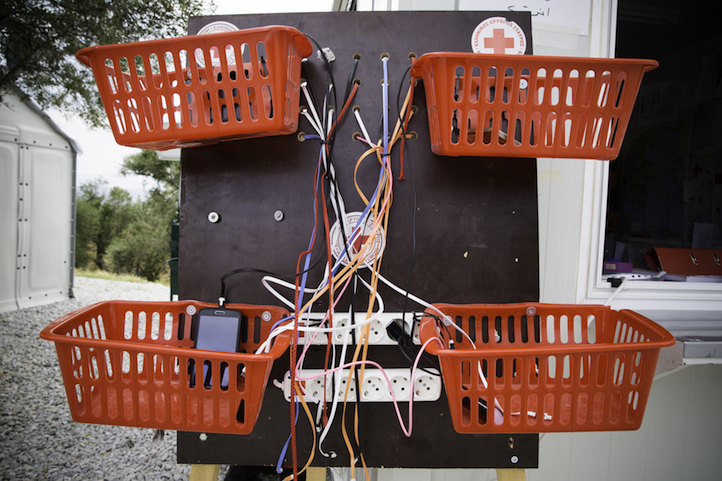
Charging stations have become gathering places for refugees and migrants, who talk and smoke while their devices power up.
Guglielmo acknowledges that on-the-ground reporting is becoming scarcer in the media landscape due to staff cuts and the need to follow popular stories that will draw traffic. Indeed, CNET, which recently posted extensive coverage of Pokemon Go, will continue to cover tech news and product reviews. “This movement towards more in-depth features is meant to complement the tech stories that we produce every single day,” she says. But that doesn’t mean travel abroad is always on the cards. “We’re looking at everything through the filter of tech: What do we want to look at? Where will that take us? How expansive do we want to be in our reporting?”
And deeper dives aren’t the only type of experimentation CNET is doing. Soon after Guglielmo joined the company, CNET launched a quarterly print publication titled CNET Magazine as another way to reach readers. The publication was conceived prior to Guglielmo’s arrival and is co-edited by Guglielmo and Lindsey Turrentine, the editor in chief of CNET Reviews. Although largely original content, the magazine will contain extracts from “Life, Disrupted.”
The “Life, Disrupted” series demonstrates how technology has helped attract attention to the refugee crisis and made life easier for those on the ground, but it also highlights that it isn’t a fix-all solution. Guglielmo reiterates a point her reporter, Richard Nieva, makes in one of his stories. “This is the most covered, Tweeted, Facebooked, YouTubed, blogged refugees crisis the world’s ever seen. Even so, tens of thousands of people remain in limbo, waiting for the help they need to get settled and find a safe place to live.”
Shelley Hepworth , formerly a CJR Delacorte Fellow, is Technology Editor at The Conversation in Australia. Follow her on Twitter @shelleymiranda.

